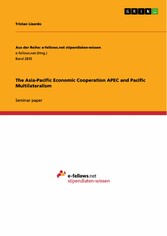Suchen und Finden
The Asia-Pacific Economic Cooperation APEC and Pacific Multilateralism
Seminar paper from the year 2016 in the subject Politics - International Politics - Topic: Globalization, Political Economics, grade: 1.0, University of Chile (Facultad de Economía y Negocios), language: English, abstract: The 'Asia-Pacific Economic Cooperation' (APEC) was established in 1989, and holds 21 so called member economies, all located on the Pacific Rim. Each member represents a particular economic region rather than individual states which is illustrated in Exhibit 1. APEC's main goal is promoting 'sustainable economic growth and prosperity in the Asia-Pacific region' (Achievements and Benefits, 2016). This is supposed to be reached primarily by the establishment of the Free Trade Area of the Asia-Pacific (FTAAP). However, APEC is working on many different topics and various alliances have been formed in order to enable free trade and investment, good cooperation among members, regional economic integration, enhancing human security and facilitating a favorable sustainable business environment in the Asia-Pacific. The organization works as a cooperative and multilateral economic trade forum. A defining characteristic of APEC is that it is the only international intergovernmental bundling in the world aiming to reduce trade barriers to trade and investment without postulating legal binding contracts and therefore encourages participation and structural flexibility. APEC has enjoyed great success as an international forum for discussion among the world's leaders in politics, business and academia. However it has made limited progress in regional integration and cooperation in areas such as financial infrastructure with a slow response time to emerging world trends.
Alle Preise verstehen sich inklusive der gesetzlichen MwSt.







